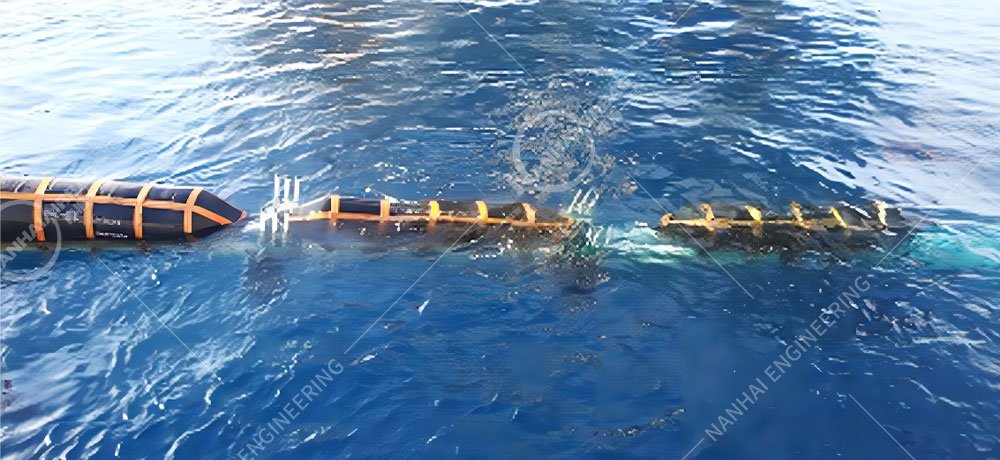Ship Launching Airbags: The Rubber Workhorses That Make Ship Launches Smooth (And Save Millions)
09/10/2025Pneumatic Rubber Fenders: The Dock & Ship Savior You Didn’t Know You Needed
16/10/2025

Imagine standing at the dock, watching a 300-meter container ship glide effortlessly into port. Ever wonder how it avoids scraping the concrete pier—or why it doesn’t tip over during launch? The answer lies in a piece of marine tech you might overlook: buoyancy rubber airbags. These flexible, air-filled rubber cylinders are the silent guardians of ports, shipyards, and offshore projects worldwide. And right now, they’re more important than ever.
What Exactly Are Buoyancy Rubber Airbags?
Buoyancy rubber airbags are cylindrical or elliptical structures made from layered high-strength rubber (think natural rubber or neoprene) reinforced with polyester cords. Filled with compressed air, they serve two key roles: providing buoyancy to support heavy objects (like ships or offshore platforms) and absorbing impact from waves, docking, or launching. Unlike rigid fenders, they’re flexible—conforming to irregular shapes like a ship’s hull or a pier piling—and reusable, with adjustable air pressure to fit different needs.
Where Do These Airbags Shine?
You’ll find buoyancy rubber airbags in some of the toughest maritime jobs:
- •Ship launching: Supporting new vessels as they slide off the slipway.
- •Docking/undocking: Cushioning ships against piers to prevent hull damage.
- •Offshore projects: Stabilizing oil rigs, wind turbines, or aquaculture cages in rough seas.
- •Salvage operations: Lifting sunken vessels or debris.
Their portability makes them a go-to for temporary jobs too—like repairing a damaged dock or assisting a stranded ship.
Why This Matters Now: The Cost of Ignoring Upgrades
Let’s cut to the chase: outdated marine protection is expensive and dangerous. Here’s why buoyancy rubber airbags aren’t just a “nice-to-have”—they’re urgent:Last year, a major port in Europe had to shut down for five days after a rigid rubber fender cracked under a ship’s weight. The damage? $800,000 in hull repairs andlost revenue from delayed cargo. Climate change is making storms stronger—traditional fenders can’t handle the increased wave force. And with global trade growing (11 billion tons of goods moved via ports in 2024!), ports can’t afford downtime.Buoyancy rubber airbags solve this: they’re reusable (no need to replace entire fenders after one hit), longer-lasting (8–12 years vs. 4–6 for standard rubber fenders), and portable (you can move them to high-risk areas quickly).
Wait—Should You Care? If You’re in Maritime, Yes.
If you’re a port operator, have you ever stress-tested your fenders before a storm? If you’re a shipbuilder, have you worried about a new vessel scraping its hull during launch? If you’re an offshore energy company, have you dealt with fenders failing in rough seas?Buoyancy rubber airbags aren’t just for big players. Small marinas use them to protect docks from recreational boats. Fishing fleets rely on them to keep aquaculture cages stable. No matter your role in maritime, these airbags reduce risk, cut costs, and keep operations running.
How Do They Stack Up Against Traditional Marine Fenders?
Let’s settle the debate: buoyancy rubber airbags outperform standard rubber fenders in almost every way:
| Factor | Buoyancy Rubber Airbags | Traditional Rubber Fenders |
|---|---|---|
| Flexibility | Conforms to any shape | Rigid—only fits fixed spots |
| Reusability | Adjust air pressure/repair sections | Full replacement after damage |
| Lifespan | 8–12 years | 4–6 years |
| Portability | Easy to move | Fixed in place |
| Cost Over Time | Lower (fewer replacements) | Higher (frequent fixes) |
Real Talk: A Case Study That Proves It
Take the Port of Qingdao, China. In 2023, they switched from rigid rubber fenders to buoyancy rubber airbags for their container terminals. Result?
- •40% less dock downtime (from 12 days/year to 7).
- •$200,000 saved in fender replacements.
- •Zero hull damage incidents from docking.
The port manager said it best: “These airbags paid for themselves in six months. We’re not just saving money—we’re keeping our crews and cargo safe.”
People Also Ask
We get these questions all the time—let’s clear them up:
Q: How do buoyancy rubber airbags absorb impact?
A: Compressed air inside the bag compresses when hit, spreading force across the rubber layers. This reduces shock to both the vessel and the structure—like a pillow for a ship.
Q: Are marine airbags safe for the environment?
A: Yes. High-quality airbags use non-toxic rubber that won’t leach chemicals into water. They’re also recyclable at the end of their lifespan.
Q: Can I use them for small boats?
A: Absolutely. Smaller airbags (1–2 meters long) are perfect for docks with fishing boats or yachts. They’re lightweight enough to move by hand.
Q: How do I maintain buoyancy rubber airbags?
A: Easy—inspect for cracks every 6 months, keep them away from sharp objects, and store them in a cool, dry place when not in use. Most manufacturers offer maintenance guides for free.
Final Thought: Don’t Wait Until It’s Too Late
Buoyancy rubber airbags aren’t a luxury—they’re a necessity for a world where maritime trade is booming and climate change is escalating risks. Whether you’re protecting a giant container ship or a small marina, these airbags give you peace of mind: knowing your assets are safe, your downtime is minimal, and your costs are under control.Ready to upgrade? Start by assessing your high-risk areas (docks, launch slips, offshore sites). Then, choose a reputable manufacturer that offers customizable sizes and warranties.Your future self (and your bottom line) will thank you.Keywords: buoyancy rubber airbags, marine airbags, marine fenders, rubber fenders, port safety, offshore equipment
